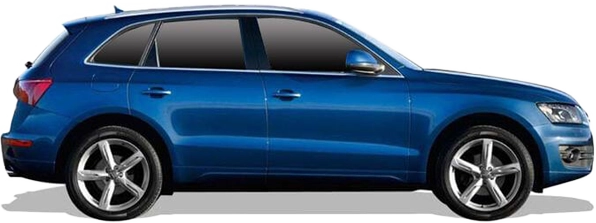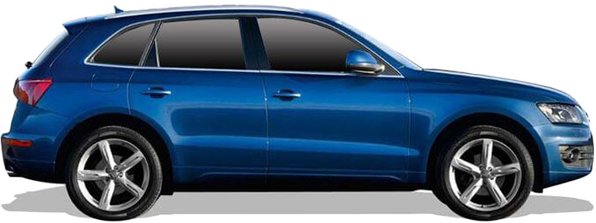The Comparative Analysis :
Mercedes EQC 400 4MATIC (19 - ..) vs. Audi Q5 2.0 TFSI quattro S tronic (08 - 11)
€ 71,300

€ 43,900

€ 71,300
Base Price ⓘBase price of a new vehicle with standard equipment in Germany at market launch.
€ 43,900
ⓘBase price of a new vehicle with standard equipment in Germany at market launch. Price Info
Vehicle Dimensions
The dimensions of these vehicles differ slightly. The Mercedes EQC 400 is 5.2 inches longer, 0.2 inches wider and 1.1 inches lower than the Audi Q5 2.0 TFSI.
Mercedes EQC 400
Audi Q5 2.0 TFSI
63.9
74.2
82.5
65.1
74
82.2
74.2 in
Width
74 in
82.5 in
Width Incl. Mirrors
82.2 in
63.9 in
Height
65.1 in
113.1
187.5
110.5
182.2
187.5 in
Length
182.2 in
113.1 in
Wheelbase
110.5 in
Vehicle Weight
Mercedes EQC 400
Audi Q5 2.0 TFSI
5501 lb
Curb Weight
4034 lb
6482 lb
Gross Vehicle
Weight
Weight
5214 lb

Weight Difference:
1466 lb
26.65 %

General
Mercedes EQC 400
Audi Q5 2.0 TFSI
N293
Generation
8R
Sport Utility Vehicle
Car Body Style
Sport Utility Vehicle
Electricity
Fuel Type
Mid-Grade Unleaded

Permanent all-wheel drive (AWD)
Drivetrain
Permanent all-wheel drive (AWD)

1-speed automatic transmission
Transmission
7-speed dual clutch transmission
Engine
Mercedes EQC 400
Audi Q5 2.0 TFSI
Asynchronous motor
Engine Type
Straight-four gasoline engine with turbocharger
Engine Code
CDNC, CAEB, CPMA
0
Valves
4
0
Cylinders
4
0 L / 0 cu in
Displacement
2 L / 98 cu in
402 hp
at 0 rpm
Power
208 hp
at 4300 rpm
Mercedes EQC 400
402 hp
208 hp
Audi Q5 2.0 TFSI
561 lb‑ft
at 0 rpm
Max. Torque
258 lb‑ft
at 1500 rpm
Mercedes EQC 400
561 lb‑ft
258 lb‑ft
Audi Q5 2.0 TFSI
Performance
Mercedes EQC 400
Audi Q5 2.0 TFSI
112 mph
Maximum Speed
138 mph
5.1 sec
Acceleration 0 to 62 mph
7.2 sec
62 mph
62
mph
mph
233 ft
0.000 sec

Mercedes EQC 400
62 mph
62
mph
mph
328 ft
0.000 sec

Audi Q5 2.0 TFSI
▶ REPLAY
13.68 lb/hp
Weight-to-Power Ratio
19.39 lb/hp
Mercedes EQC 400
13.68 lb/hp
19.39 lb/hp
Audi Q5 2.0 TFSI
Fuel Economy / Emissions
Mercedes EQC 400
Audi Q5 2.0 TFSI
Fuel Economy
32 kWh✽
( 105 MPGe ⓘ Miles per gallon gasoline equivalent (MPGe) is a measure of the average distance traveled per unit of energy consumed. MPGe, specified in miles per U.S. gallon, is used to compare the energy consumption of vehicles that use different energy sources.)
combined ✽ per 100 miles
27 mpg
Mercedes EQC 400
105 MPGe
27 mpg
Audi Q5 2.0 TFSI
No data
city
22 mpg
No data
highway
No data
80 kWh
Fuel Tank Capacity
19.8 gal
252 mi
Range
542 mi
Mercedes EQC 400
252 mi
542 mi
Audi Q5 2.0 TFSI
Environmental Impact
64.1 kWh
Total Energy Consumption
per 100 miles ⓘThe total energy consumption per 100 miles is the amount of energy consumed by a vehicle when burning fuel or using electricity per 100 miles (final energy), and the energy required to produce the appropriate amount of fuel or electricity (primary energy).
per 100 miles ⓘThe total energy consumption per 100 miles is the amount of energy consumed by a vehicle when burning fuel or using electricity per 100 miles (final energy), and the energy required to produce the appropriate amount of fuel or electricity (primary energy).
162.9 kWh
Mercedes EQC 400
64.1 kWh
162.9 kWh
Audi Q5 2.0 TFSI
Elektrofahrzeug
Emission Standard
Euro 5
0 g/mi (WLTP)
CO2 Emissions
320 g/mi (NEFZ)
Practical Convenience
Mercedes EQC 400
Audi Q5 2.0 TFSI
5
Doors
5
5
No. of Seats
5
981 lb
Maximum Payload
1179 lb
14.2 cu ft
Trunk Volume
15.3 cu ft









41.3 cu ft
Cargo Volume (Seats Down)
44.2 cu ft















